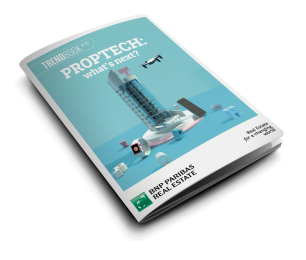The future of building design
With the reduction in lease length from 20 years in the past to now where we sometimes see leases for one month in co-working contexts, building design has become a crucial element. As new technologies help to collect more data on the people using the buildings, this data can be used in the early stages of the design of a building in order to increase happiness, productivity, and loyalty in its users.
New factors are starting to become increasingly important when it comes to the way that buildings are designed. As people are more concerned with having a positive experience at work, they start to consider the building environment as a whole. The location of the building is essential, as well as its surroundings and transportation links. The facilities in and around the building are crucial too, ranging from lunch options to other amenities that are available. Employee happiness and productivity levels are becoming more and more important to employers, who are starting to take everything from better office lighting to healthier lunch options into consideration. After all, high productivity levels and happy employees are the best way to retain current talent and attract future employees. As companies become more socially conscious, other areas that both companies and employees consider are things like sustainability and carbon and energy use. Integrating some or all of these aspects into the building from the early design stage is essential in order for it to be successfully executed.


Employee happiness and productivity levels are becoming more and more important to employers, who are starting to take everything from better office lighting to healthier lunch options into consideration. After all, high productivity levels and happy employees are the best way to retain current talent and attract future employees.
Incorporating new technologies into building design
When it comes to incorporating new technologies into building design, there are several advantages. For example, an office building should be a human-focused space with a positive environment and user experience, and the way to achieve that is by better understanding the people that the building is being designed for. The data collected on the inhabitants of the building can be used, in combination with new technologies, to improve the user’s experience of that building. For instance, facial recognition sensors could indicate that a person is cold, and then the temperature of the building or office space could be automatically increased, resulting in a happier employee with a higher productivity rate. Or, the ability to analyse how the type of fruit that’s in the canteen changes a person’s moods and productivity levels according to collected data could be crucial when deciding on office canteen offerings. Seen in this light, data collection through new technologies, apps, etc. can have a positive effect on the people who work or live inside the building, creating an overall better user experience. Technology is a tool that can make lives easier and more efficient, and building environments should be more responsive to people’s needs. The real estate sector is still in the very early stages of this notion, but technology and data will definitely be significant drivers in the long-term by improving the environment for the people that matter the most: the customers or the inhabitants of the building.
The drawbacks of data collection and the importance of ethics
However, there are certain drawbacks to the increase in technological developments and data collection in buildings. Issues like cybersecurity and personal privacy are crucial not only on a personal level, but also should be kept in mind at the conception stage of the building. On a major scale, data collection, image recognition, and artificial intelligence can reveal large amounts of personal information regarding a person’s health, happiness, and current physical location. While in the best-case scenario this data is collected to optimise the building for each individual in it, people’s comfort levels in releasing such data vary from one person to another. That’s why the ethics of technology are an important area to consider when designing a smart building or city. In this way, data ethics are one of the primary focuses for a new, not-for-profit initiative called the Real Estate Data Foundation. They have published six, high level data ethical principles that they are encouraging real estate companies to work towards to help them take the first steps in the right direction
In conclusion, increased technological developments will become a bigger part of our lives as buildings become more experience-orientated. The future role of the real estate sector will be, in part, to help individuals and clients make decisions. Striking the right balance between implementing useful technologies that are accepted by the customer and the user is key to moving forward in the right direction.

Download the PropTech TrendBook
Find out how sustainability, investment and collaboration are being changed across Europe.




